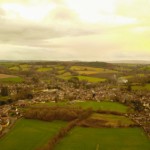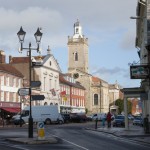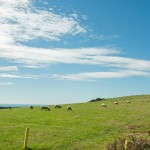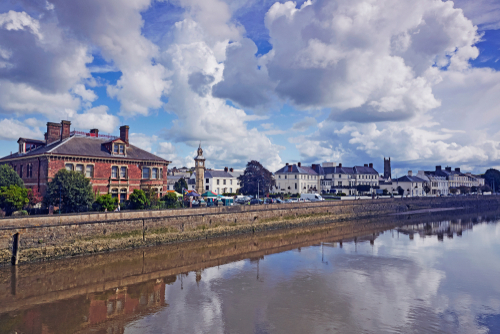
A quick guide to Barnstaple
Barnstaple is a civil parish and the main town of North Devon, southwest England. It lies about 7 miles (11 km) inland from Barnstaple Bay in the Bristol Channel. It’s also situated around 68 miles (109 km) southwest of Bristol, 50 miles (80 km) north of Plymouth and 34 miles (55 km) northwest of Exeter. One of Barnstaple’s main claims to fame is that it is often cited as being the oldest borough in the UK. The town’s name is often mispronounced or even spelt as “Barnstable”, but the word ‘’staple” is an old Anglo-Norman term for ‘’market’’, and in particular, that for sheep. The population of Barnstaple, at the UK 2011 National Census, was recorded as 24,033.
A Fleeting History
The earliest known settlement of the Barnstaple area was at Pilton, a present-day suburb of the town that is situated on the banks of the River Yeo. Records of the ancient Anglo Saxon ledger document ‘Burghal Hidage’, dated around 917 AD, shows that Barnstaple was one in a network of defensive ‘burh’ settlements set up by Alfred the Great to ward off attacks by the Vikings. Thus, as early as the 10th century Barnstaple was a well establish and important town, even having its own Mint.
After 1066, following the Norman Conquest, the baronial seat for the area was established at Barnstaple Castle. The large barony was bestowed by William the Conqueror to Geoffrey de Montbray, as recorded in the Domesday Book of 1086. However, in 1095, the barony reverted to the ownership of the crown after Robert de Montbray decided to join the rebellion against King William II. Just before his death in 1100, the king granted the Barnstaple barony to Juhel de Totnes. In 1087, the former Baron of Totnes was deprived of his barony by William following the death of his father.
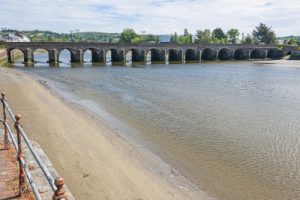
Barnstaple’s famed 13th century Long Bridge
Around 1107, Juhel, who had previously founded Totnes Priory, similarly founded Barnstaple Priory. St Peter’s Church, the town’s oldest in the town, dates from the same time. Around 1139, Juhel’s son, Alfred, died without an heir, so the barony was passed to his two sisters and subsequently split. However, in 1213, the barony of Barnstaple once again become a single entity falling under the tenure of Henry de Tracy. In 1228, the town’s castle walls were partly demolished to reduce its potential as a stronghold in the event of a rebellion.
Sometime during towards the end of 13th century, Barnstaple’s famed ‘Long Bridge’ was built, linking the town with Tawstock, while spanning the River Taw. The quaint bridge has 16 masonry arches of various width, with a total span of 522 ft (159 m).
In 1340, Barnstaple’s merchants sought the free trade rights granted to the borough by King Athelstan during Saxon times. The privilege was granted by Edward III but the status did not go unchallenged from time to time by Barnstaple’s subsequent Lords of the Manor. The town’s self-governing status gave it obvious advantages and the port was soon developed, becoming particularly important in the export of wool. The Guild of St. Nicholas was soon formed to look after the interests of wool merchants from Barnstaple and the surrounding area. The port grew steadily through the reign of Edward III (1327 – 1377) being used by the navy as well as merchant ships.
Important as the town was, even at the end of Edward III’s reign in 1377, the adult population of Barnstaple was still no more than 680. However, it still managed to maintain its position of second only to Exeter in terms of Devon’s wool trade until the end of the 16th century.
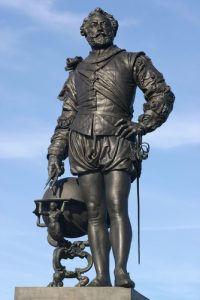
Barnstaple contributed five ships to Drake’s Fleet that defeated the Spanish in 1588
In 1588, the town provided five ships to Francis Drake’s fleet that was gathering at Plymouth harbour prior to his historic victory over the Spanish Armada. England’s other great seafaring heroes such as Sir Walter Raleigh and Sir Richard Grenville also relied on Barnstaple to supply both men and ships for their quests.
At the start of the English Civil War in 1642, Barnstaple sided with the King against Parliament, but it was taken and then retaken by the two sides several times, during the 9-year conflict. In 1713, the merchant’s exchange building was built. However, during the 18th century Barnstaple lost one of its mainstay industries when the manufacture of woollen garments ceased. Instead, it began importing wool from Ireland but the raw material was sent inland to some of Devon’s new cloth-making towns.
While the town’s maritime tradition did continue into the 19th century, mostly shipping goods to Europe and the Americas, Barnstaple had the problem that its harbour was gradually silting up. Bideford, lower down the estuary, gradually took what had once been Barnstaple’s foreign trade. However, Barnstaple managed to retain its manufacturing importance until the early 20th century, as the lace, sail-cloth, pottery, tannery, sawmill, iron foundry and shipbuilding industries, were all still active.
In 1826 the present Guildhall was built. In 1848, the first railway line to Barnstaple opened, initially for the movement of freight to and from Fremington Quayside. It was another 6 years before passenger services were introduced between Barnstaple and Crediton with North Devon Railway operating the line. In 1855, the town’s Pannier Market, which was designed by the Borough Surveyor, Richard Davey Gould, was opened. Despite a number of townsfolk having great misgivings, the market became an instant success. Butcher’s Row was built at the same time to house those butchers that were displaced by the building of the new covered market.
In 1862, following the death of Prince Albert, the ‘Albert Clock’ was erected in his memory in ‘The Square’. In August 1879, the town’s Rock Park opened, bequeathed to Barnstaple’s townsfolk by the locally born benefactor, William Frederick Rock. In 1898, Town Station opened offering passenger services to Ilfracombe and Lynton. The station replaced the earlier built Quay Station, and while it still stands today, trains to Lynton ceased running in 1935, and to those to Ilfracombe in 1970.
Between the 1930s and the 1950s, Barnstaple continued to grow steadily, swallowing up the villages of Pilton, Newport, and Roundswell in the process.
The Modern Era
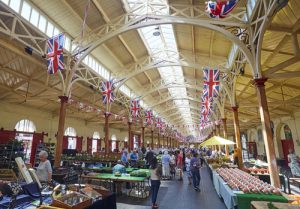
The Victorian Pannier Market – built in 1855
Barnstaple currently has a population of some 25,000 plus, with the figure doubling if the immediate outlying areas are included in the count. In a fast expanding town, new housing developments are expected to add around 8,000 to the population in the next 15 to 20 years. Barnstaple also has a relatively large town centre, spanning both sides of the River Taw, that has a wide selection of major national retailers and independent shops.
The town has managed to preserve many of its historic monuments and buildings, which include the Guildhall, the Pannier Market, St Anne’s Arts & Community Centre, Penrose and Pilton Almshouses, the Albert Clock and Queen Anne’s Walk.
Major events in the Barnstaple calendar include Barnstaple Fair, Barnstaple Carnival, and Pilton Green Man Day. Barnstaple Fair is said to be the oldest in the country with its origins dating back to 930. It’s a 3-day event held every September, where the Carnival takes place on the last day of the Fair. Pilton Green Man Day is normally held on the third Saturday in July and has its roots in pagan practice celebrating nature and fertility. The day of festivities was only revived in the 1980s after more than a couple of centuries of lapse. On the day, the usual parades, pageants and associated activities of such celebrations can be expected, along with copious amounts of food, drink and music.
Barnstaple has a strong local economy, with major employers in the retail, tourism, manufacturing, scientific, health and education sectors. Unemployment in the area is below that of the national average. Additionally, the town has a good supporting transport infrastructure, which includes a railway station, a bus station and good road links to the M5, as well as Exeter and Plymouth.
Getting there!
By Car
From most of the country the best way to Barnstaple is via the M5, then the A361, A39 and A377, following the signs for the town.
Train
Barnstaple is the terminus station on the 39-mile long branch line from Exeter St David’s. Trains run approximately every hour from morning to late evening, with a reduced service on Sundays. The service is operated by Great Western Railways (GWR).
By Bus
National Express and Megabus run intercity bus services to Barnstaple bus station, which is situated in the town centre. There are direct services from London but travellers from other places may need to change at Bristol.
By Air
The nearest airport to Barnstaple is Exeter (EXT) which is 37 miles (59 km) away. Other nearby airports include Cardiff (CWL) 38 miles (61 km) away and Bristol (BRS) 63 miles (100 km) away.
Barnstaple Town FC
Barnstaple Town Football Club, founded in 1904, currently (2020) play in Division One of the South & West Division of the Southern League. They play their home games at Mill Road, which has a capacity of 5,000 with some 250 seats.
Celebrated Residents

John Gay – born in Barnstaple in 1685
Some of Barnstaple’s most celebrated sons include:
- Sir Francis Chichester (1901 – 1972) – born close to Barnstaple, a pioneering aviator and sailor, he was the first person to sail single-handed around the world following the clipper route.
- John Gay (1685 – 1732) – born in Barnstaple was a famed poet and dramatist of his time, who’s most renowned work, ‘The Beggar’s Opera’ (1728), was a hugely popular ballet opera of the time.
- Nigel Brooks – born in Barnstaple in 1936, is a renowned composer, arranger and conductor, particularly known for conducting the BBC Concert Orchestra.
- Phil Vickery Philip, MBE – born in Barnstaple in 1976, is a former England rugby union player, who was a member of the World Cup-winning squad of 2003.
Quirky Barnstaple!
The Four-Faced Liar
The Albert Memorial clock tower, one of Barnstaple’s chief landmarks is known locally as “The four-faced liar”. The clock tower, dating from 1862, was paid for by public subscription having been designed by R D Gould, the borough surveyor. It gets its nickname from the fact that it has over many years displayed slightly different times on each clock face. In 2009, the clock was given a complete overhaul but the local authority decided to retain its idiosyncratic character. Thus, the clock, which can often show four (albeit slightly) different times, is now considered a distinct feature of the town.
A Mammoth Task
In February 1844, some rare mammoth fossils were unearthed in Summerland Street in the town centre. Mammoths have been extinct in the UK for at least 115,000 years. Some of the tusk and bone fragments from the find are still on show at Barnstaple Museum. Larger finds, such as whole teeth, were taken to London’s Natural History Museum.
Things to see and do!
Some of the sights and attractions in and around Barnstaple include:
- Barnstaple Castle – is now only a tree-covered mound, which is the remains of the old ‘motte’ that indicates the spot where the castle once stood. A surrounding park is a popular place for leisure activities.
- Museum of Barnstaple and North Devon – situated near the clock tower, the museum tells much of the natural and human history of the area. The site has a gift shop, tearoom and tourist information desk.
- Tarka Trail – is a 180-mile long walkers and cyclists trail that winds through Devon. The trail name is adopted from the famed ‘Tarka the Otter’ novel, which is set in North Devon. Bikes can be hired near the train station.
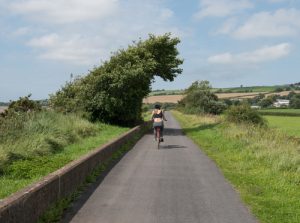
‘South Coast West Path’ – close to Barnstaple
- Pannier Market – is one of the West country’s largest. The historic indoor market runs 6 days a week, offering a vast range of fresh produce, arts, crafts, collectables and antiques.
- South West Coast Path – passes within a few miles of Barnstaple. The short Taw Estuary walk from the town gives access to the Coast Path.
- Arlington Court – is a neoclassical style country house with formal gardens. Dating from 1823, the Grade II listed building is situated about 5 miles north of Barnstaple.
- Exmoor Zoo – is a small animal conservation centre at Exmoor. The zoo cares for some 175 species of animals, birds and reptiles and is situated about 10 miles north of the town.
- Barnstaple Long Bridge – is a medieval bridge that links Tawstock with Barnstaple, spanning the River Taw. One of the largest medieval bridges in Britain, it’s a Grade I listed structure.
Where to stay?
There’s a fairly limited amount of accommodation in Barnstaple itself although the surrounding area obviously offers more options. In Barnstaple and the general area expect to pay something around the following for accommodation for 2 adults sharing:
B&B/Guesthouse/Lodge: £60 – 100
Hotel: £100 – 150
Luxury Hotel: £150 – 250

